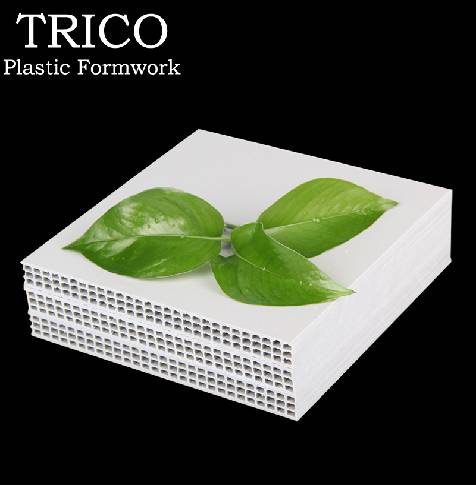my country’s construction industry industry standards point out: Plastic Formwork Board is made of thermoplastic rigid plastic as the main material, glass fiber, plant fiber, anti-aging agent, flame retardant, etc. as auxiliary materials, and is manufactured by extrusion, molding, injection molding and other industries. A template for concrete structure engineering. The wood-plastic composite template, which is easily confused with the concept of plastic template, is defined in the American Society for Testing and Materials (ASTM) as a composite material mainly composed of wood or fiber as the basic material and plastic. The types of the main materials and auxiliary materials in the two templates are opposite, which determines that the two templates are both similar and different. In normal use, both materials are considered plastic templates.
Plastic template is an energy-saving, green and environmentally friendly product. It has excellent water absorption, corrosion resistance, acid and alkali resistance, impact resistance, abrasion resistance, light weight, smooth and clean surface, good workability, recyclability and other properties. It has become the ideal product for global construction of plastic to replace wood, plastic to replace steel, and plastic to replace bamboo, and it is the future development direction of the Formwork Industry.
Plastic template turnover can reach more than 50 times, and it can be recycled. Wide temperature adaptability range, strong specification adaptability, can be sawed and drilled, easy to use. The flatness and smoothness of the surface of the formwork exceeds the technical requirements of the existing fair-faced concrete formwork. It has the functions of flame retardant, anticorrosion, water resistance and chemical corrosion resistance, and has good mechanical properties and electrical insulation properties, which can meet various requirements. Cuboid, cube, L-shaped, U-shaped building support requirements.

Plastic Formwork Board
1. Smooth and clean. The Aluminium Formwork is spliced tightly and smoothly. After demoulding, the surface flatness and smoothness of the concrete structure exceed the technical requirements of the existing clear water formwork. No secondary plastering is required, saving labor and materials.
2. Lightweight and easy to install. Light weight, strong process adaptability, can be sawed, planed, drilled, nailed, and can be formed into any geometric shape at will to meet the needs of various shapes of building support.
3. Easy demoulding. The concrete does not stick to the board surface, does not require a release agent, is easily demoulded, and is easy to clean dust.
4. Stable and weather resistant. High mechanical strength, no shrinkage, no swelling, no cracking, no deformation, dimensional stability, alkali and corrosion resistance, flame retardant, waterproof, rodent and insect repellent under the temperature conditions of -20 to 60 degrees Celsius.
5. Conducive to maintenance. The template does not absorb water and does not require special maintenance or storage.
6. Strong variability. Types, shapes and specifications can be customized according to the requirements of construction projects.
7. Reduce costs. There are many turnover times, the plane mold is no less than 30 times, and the column beam mold is no less than 40 times, so the use cost is low.
8. Energy saving and environmental protection. All scraps and used templates can be recycled, zero waste discharge.
Previous: Jewelry boxes
Copyright:@2020-2021
Comments Please sign in or sign up to post.
0
0 of 500 characters used